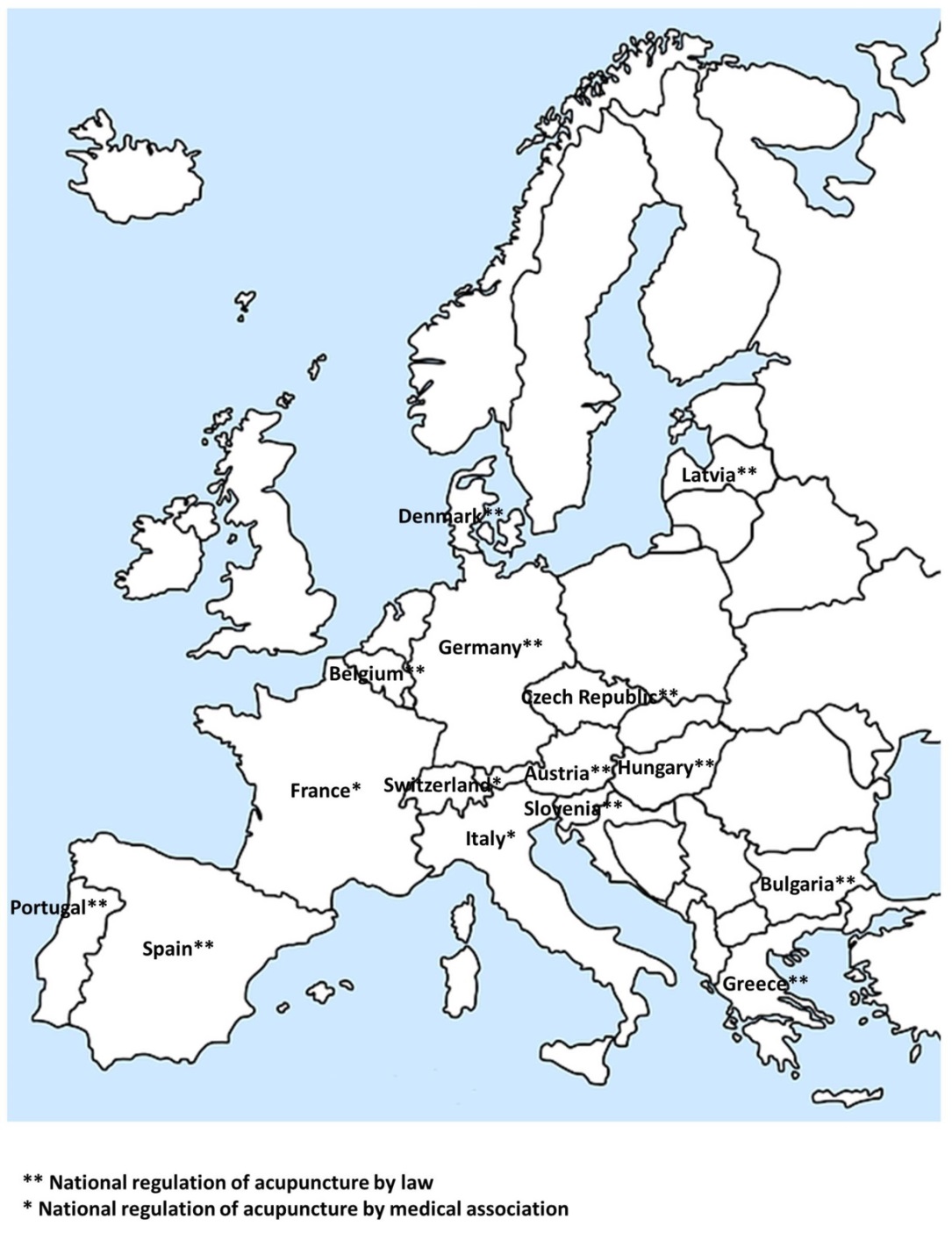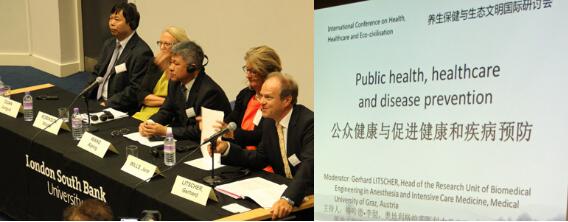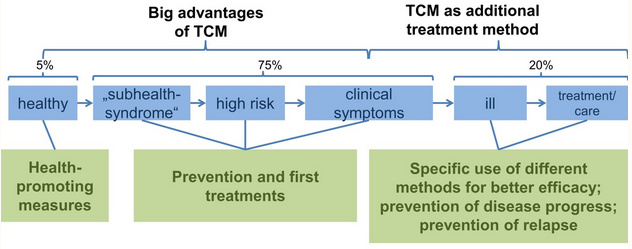Modernization of Acupuncture Education in Europe and China: A Report from Austria
Daniela Litscher †![]() , Gerhard Litscher †,*
, Gerhard Litscher †,*![]()
Research Unit for Complementary and Integrative Laser Medicine, Research Unit of Biomedical Engineering in Anesthesia and Intensive Care Medicine, and TCM Research Center Graz, Medical University of Graz, Auenbruggerplatz 29, 8036 Graz, Austria
† The authors contributed equally to this work.
* Correspondence: Gerhard Litscher ![]() .
.
Received: May 24, 2016 | Accepted: June 10, 2016 | Published: August 15, 2016
OBM ICM 2016, Volume 1, Issue 1, doi:10.21926/obm.icm.1601002
Academic Editor: Jack Warren Salmon
Recommended citation: Litscher D, Litscher G. Modernization of Acupuncture Education in Europe and China: A Report from Austria. OBM ICM 2016; 1(1): 002; doi:10.21926/obm.icm.1601002.
© 2016 by the authors. This is an open access article distributed under the conditions of the Creative Commons by Attribution License, which permits unrestricted use, distribution, and reproduction in any medium or format, provided the original work is correctly cited.
Abstract
The present report deals with some current important aspects of traditional Chinese medicine (TCM) education and practice in Europe and China. The data and facts are based on a lecture of one of the authors (G.L.) prepared for a conference in Wuhan about acupuncture education in Europe, and lectures of two high-ranking representatives of renowned Chinese institutions (State Administration of TCM and Heilongjiang University of Chinese Medicine, Harbin). In addition to current figures regarding TCM in general, the advantages of TCM are reported, and special cooperations of the important university in the North of China are introduced.
Keywords
Acupuncture; Education; Practice; Europe; Austria; China; Modernization
Acupuncture in Europe
Acupuncture is the best-known and most widespread part of traditional Chinese medicine (TCM) in the western world. Acupuncture as a distinct therapeutic system is recognized by law in 12 European Union (EU) member states (Austria, Belgium, Bulgaria, Czech Republic, Denmark, Germany, Greece, Hungary, Latvia, Portugal, Slovenia and Spain; Figure 1) [1].

Figure 1 Acupuncture in the European Union (modified from [1]).
In Austria, Bulgaria, the Czech Republic, Greece, Hungary, Latvia, Slovenia and Spain, only medical doctors are allowed to perform acupuncture. In Belgium and Portugal the law does not explicitly exclude non-medical practitioners, but this has not yet been implemented. In Denmark everyone, both individuals with and without a medical authorization, is allowed to perform acupuncture for therapeutic purposes. In Austria, Bulgaria, Germany, Italy, Portugal, Spain and Switzerland the diplomas of medical acupuncturists are issued by the national medical association / chamber/ council, in other countries usually by the national medical acupuncturists’ association. Diplomas issued by the national medical acupuncturists’ association are officially approved by the government in Latvia and are recognized by the national medical council / chamber in the Czech Republic and Italy. Approximately 80,000 medical doctors in the European Union have undergone training and education in acupuncture [1].
Special Situation in Austria
Since 1986, acupuncture is officially acknowledged as a scientific cure in Austria. According to data from 2011, 3531 doctors hold the acupuncture diploma from the Austrian medical association [2], but today there will be a lot more. Exemplarily, these associations in Austria are allowed to teach the ÖÄK acupuncture diploma course: “Doctors for Acupuncture“ (Vienna), “Austrian Society for Acupuncture“ (Vienna) and “Austrian Society for Controlled Acupuncture and TCM“ (Graz). The goal of such TCM courses is to teach knowledge and skills in acupuncture in theory and practice. The audience consists of general practitioners and medical specialists of all subjects. Students of medicine can start the diploma education during the last study section. This advanced education takes at least 18 continuous months and includes 180 teaching units (TUs). The course is divided into 120 theoretical and 60 practical TUs. The practical part of the education should last at least nine months and can only be started after at least 70 TUs of basic education. A maximum of 20 TUs of practice can be done on two consecutive days. Students will be credited 20 TUs of practice for working in a non-German speaking country for at least three weeks. A maximum of 10 TUs (45 minutes each) will be held. During the first 120 TUs (theory part) some basic practice aspects will also be taught, for example searching for points, needling or palpation [3].
The curriculum of Block I contains the following topics: systematics of the organic systems of the ventral circulation with acupuncture points, introduction of the medical history of TCM, presentation of acupuncture-relevant basics of TCM, systematics of the organic systems of the dorsal circulation with acupuncture points, systematics of the organic systems of the lateral circulation with acupuncture points, conception vessel, governing vessel, extra points of acupuncture, ear acupuncture I, further microsystems, pain (pain acupuncture, acute pain, chronic pain), acupuncture of the musculoskeletal system, inner dysfunctions I “TCM“, inner dysfunctions II “TCM“, science and research (overview of the most important acupuncture studies on different diseases, how to plan acupuncture studies (ethics committee, randomization, double-blinding…), placebo/sham acupuncture), repetition of knowledge of acupuncture points and practice of acupuncture. Block II consists of the so-called free theory: psychosomatic medicine, neurology, psychiatry, ear-nose-throat, midwifery/gynecology/urology, pediatrics, ophthalmology, and ear acupuncture II, hand acupuncture and other microsystems; introduction to Chinese drug therapy [3].
There are 60 TUs of practice seminars and 10 TUs about basics in practical application of acupuncture (conversation, anamnesis, treatment strategies, application of lasers, point selection). 30 TUs are used for clinical education in patients in a clinic or practice, another 20 TUs are dedicated to clinical education in patients of special fields [3].
The earliest possible date for the final examination is 18 months after starting the advanced education. This period of time is necessary to study the basics and to strengthen the practice skills. For doctors who are members of the medical association in Austria, there is a fee of about 50 Euro to pay [3].
Acupuncture at Universities in Europe
Familiarization courses about acupuncture are provided in the medical undergraduate curriculum as part of a course on Complementary and Alternative Medicine in the Czech Republic, Germany, Hungary and the Netherlands; as a separate subject in Austria, Bulgaria, France, Germany, Hungary and Spain; and as a part of Traditional Chinese Medicine in Germany and Latvia. Familiarization courses are optional for medical students in the Czech Republic, France (one university), Germany, Hungary (one university) and Switzerland (some universities), obligatory in the United Kingdom. Postgraduate training courses in acupuncture for doctors are provided at universities in the Czech Republic, France, Hungary, Latvia, Portugal and Spain, in other countries at private teaching centers. Acupuncture is an official part of the Continuous Education Program for doctors in Germany, Greece, Hungary and Latvia. A professorial chair of acupuncture exists in Bulgaria (Sofia), Hungary (Pécs) and Latvia, a chair of CAM including acupuncture in France (Nantes), Germany (Berlin), Switzerland (Bern) and the United Kingdom (Exeter, Sheffield, Thames Valley, Southampton). In Austria (Vienna, Innsbruck and Graz), single centers and/or departments dealing with TCM research exist at Medical Universities. Acupuncture research in Austria exists mainly at Medical University of Graz (see Figure 2) [1].

Figure 2 High-tech acupuncture research network initiated by Medical University of Graz.
As acupuncture continues to grow in Europe, hospitals and western health institutions increasingly incorporate medical acupuncturists as staff members of the institutions or as contractual providers. In Germany there are several hospitals providing TCM, including acupuncture (Figure 3).

Figure 3 Acupuncture in hospitals in Germany and Austria.
General Information about TCM Education in China [4,5,6]
A very interesting TCM symposium entitled "International Conference on Health, Healthcare and Eco-Civilization" was held at London Southbank University on September 5 and 6, 2015 (Figure 4). The conference was organized by the China Academy of Culture, London South Bank University and the London Confucius Institute for TCM. During the session "Public health, healthcare and disease prevention", which was moderated by the co-author of this article, the Director of the International Education College of Heilongjiang University of Chinese Medicine in Harbin, Prof. Wang Ai-Ping, spoke about the current situation of TCM education and practice in China. In addition Prof. Cao Hong-Xin, the Director General of the Department of Science and Technology of the State Administration of TCM, P.R.C., reported on the development of TCM in China [5]. Some important aspects are summarized in this paper.

Figure 4 Symposium at London South Bank University in September, 2015.
The lecturers from China reported that TCM and Western medicine are equally important in China's medical care and are considered equivalent in the Chinese health policy. They presented the following general facts about health care in the world’s most populous country: In the People's Republic of China, a total of 3,732 TCM hospitals exist with 755,050 hospital beds. Each year, approximately 515 million outpatients are treated in China, and 22.27 million people are hospitalized. There are also 39,854 TCM clinics that serve 128 million outpatients.
It is an interesting fact that according to a report of the United States and the World Health Organization (WHO), only 5% of the population are considered “healthy”. Persons classified as “subhealth syndrome” constitute 75%, and about 20% of the population suffer from at least one disease.
Figure 5 illustrates the advantages of the TCM when compared with conventional treatment methods. TCM is efficient especially in the subhealth area and when the first clinical symptoms manifest. In severe diseases, TCM is usually used as an additional treatment.

Figure 5 Advantages of TCM.
In the last 60 years a lot of energy has been invested in the development of higher education in the field of TCM in China. Already in 1956 the first colleges for TCM were established. Afterwards a total of 24 independent TCM colleges emerged. In addition, 62 institutions specifically dedicated to TCM training were established. Over 300,000 TCM practitioners were already trained at these colleges, which is also of great importance for global health care.
Immediately after the founding of the People's Republic of China, the country attached great importance to the development of TCM. Following the model of medical education in the former Soviet Union, important changes were implemented in the education system, with the target to ensure better and higher education in TCM. Especially in the 21st century, the training underwent many reforms. The implementation of clinical medicine into professional TCM training, both the master and doctor’s degree were divided into special grades of Medical Science and "TCM professional degree". In recent years, the practical TCM education was completely redesigned, and excellently trained TCM practitioners were educated thanks to medical cooperations as well as cooperations among universities. The TCM training includes five years of study; three more years are designated to provide standardized training. A total of eight years will be needed for the full completion of the training to become a TCM doctor.
TCM education for students contains the integration of TCM in modern science, and the integration of TCM in western medicine. Furthermore, TCM training includes the integration of humanities, social and natural sciences. There are compulsory courses such as a basic course in humanities and social sciences, foreign languages, sports units, information sciences, basic courses in TCM, basic courses in clinical TCM, basic courses in western medicine, clinical courses for TCM and clinical courses for western medicine. There are also optional subjects such as specific scientific methods and specialized courses of clinical TCM and western medicine including prevention and rehabilitation.
The Chinese Ministry of Education has recently issued a regulation entitled "Reforms of teaching contents and curricula of the higher education system in the 21st century", 15 regulations of which are allotted to TCM. Based on that, a number of reforms were carried out in the curriculum of TCM. Interdisciplinary curricula were created and national performance rates were introduced. At the same time the production of textbooks has been accelerated; seven versions of TCM textbooks are now used at higher universities. These policies are not only the framework of basic education and clinical practice, but also led to a coherent education system in TCM.
Internationalization is increasingly becoming one of the most important strategic objectives in the reform and development of higher education in the 21st century. The higher education of TCM has already begun this process of internationalization. About 3,000 foreign students come to China to learn TCM, representing the largest part of exchange students.
In the following, TCM training at Heilongjiang University of Chinese Medicine will be presented in more detail. Foreign students whose Chinese language skills are on HSK level 5 (knowledge of 2500 Chinese characters needed; able to easily read a Chinese newspaper and to follow a film), can study together with Chinese students, using the same textbooks and taking the same courses (exempt political education), and the same tests must be completed together with Chinese students. In addition, the course "Chinese in TCM" was founded to combine the knowledge of TCM and Chinese. Learning Chinese is seen as the main goal and the knowledge of TCM as a secondary objective to increase the learning effectiveness.
For students who have not previously learned Chinese, an English version of the textbooks is offered. They attend a separate class, and are taught by specially trained bilingual teachers; if necessary, a translator is consulted. Most of these students specialize in acupuncture and massage.
In 2008, a cooperation was started with the Southwest Acupuncture College (USA). At Heilongjiang University the practical clinical training of American students takes place. Students have the opportunity to visit different areas in the connected hospitals and also to practice there, for example: acupuncture, massage, rehabilitation, Chinese internal medicine and four English-language lectures on Chinese medicine. After successful completion of all internships, the students receive a certificate.
Since 1999, Heilongjiang University cooperates with the TCM school in Kuala Lumpur (Malaysia) in a 5-year medical academic education without a doctorate degree. The two universities jointly develop a plan for training and teaching programs. The students receive a diploma and a certificate from Heilongjiang University. Requirements are the completion of the full course of study and passing all tests.
In 2010, the cooperation with Semmelweis University in Budapest (Hungary) began. It is a five-year course. The first four years are spent in Hungary with mostly theoretical courses; the last year is carried out as a practical year at Heilongjiang University. This course is taught in English.
In 2014, Heilongjiang University has started a cooperation with the Merchants Association of Chinese Herbs in America to set up a 4-year degree program in the field of pharmacy in San Francisco. The study plan is designed based on the American education system. In the first two years, students learn about pharmacy in the United States, in the other two years there are laboratory courses, internships and case studies to be completed. At Heilongjiang University, qualified teachers from the region give the lessons; on the other hand, outstanding teachers are sent to America. For this course the students receive a diploma and degree certificate from Heilongjiang University of Chinese Medicine.
Now we are faced with an optimistic situation: TCM is becoming more and more popular in the world, and its basic medical concepts of holistic health and their clinical benefits are recognized by more and more people. There are TCM doctors and educational institutions all over the globe, and there is much collaboration in this field.
TCM as an important part of medical sciences constitutes a promising branch of the global economy. The development of TCM will move towards globalization through its increasing influence on the international community. It is therefore necessary to standardize TCM training. Not only will practical TCM training be uniform worldwide, the development and quality of all TCM schools will also be improved. The target is the globalization of TCM.
Acknowledgments
The first part of the article is based mainly on a lecture prepared by G.L. for the International Acupuncture Education Congress & The Working Conference of Working Committees of the WFAS (World Federation of Acupuncture and Moxibustion Societies), which was held by Prof. Fengxia LIANG on behalf of G.L. at Hubei University of Chinese Medicine in Wuhan on May 14, 2016.
The second part of the report is based partly on translations of the Chinese lecture by Prof. Wang Aiping. In this context, we would like to cordially thank PD Dr. Lu Wang, Medical University of Graz, for the competent translation.
The authors would also like to thank Mag. Ingrid Gaischek, Medical University of Graz, for the help in the preparation of this manuscript.
Author Contributions
DL performed data research and drafted the manuscript. GL designed the underlying lecture and the article, and performed critical revision of the article.
Competing Interests
The authors have declared that no competing interests exist.
References
- CamDoc Alliance. Results: Acupuncture [Internet]. Brussels: CamDoc Alliance [2016-05-24]. Available from: http://www.camdoc.eu/Survey/Results_AC.html
- Lebensweise. Akupunktur in Österreich: die Fakten [Internet]. Unteraichwald: Gesund kommunizieren Media KG [2016-05-24]. Available from: http://www.lebensweise-magazin.at/2011/06/10/akupunktur-in-%C3%B6sterreich-die-fakten/
-
Akademie der Ärzte. ÖÄK – Diplomrichtlinie Akupunktur [Internet]. Wien: Österreichische Akademie der Ärzte [2016-05-24]. Available from: https://www.arztakademie.at/fileadmin/template/main/OeAeKDiplome
PDFs/Diplom-Richtlinien/RL15_Akupunktur.pdf - Wang AP. The current situation of higher education for TCM in China and the mode of international education. Proceedings of International Conference on Health, Healthcare and Eco-civilisation; 2015 September 6; London, UK.
- Cao HX. “The oneness of man and nature” in relation to wellbeing and healthcare. Proceedings of International Conference on Health, Healthcare and Eco-civilisation; 2015 September 6; London, UK.
- Litscher D, Litscher G. Aktuelle Aspekte zur TCM-Ausbildung und -praxis in China. Akupunktur und Aurikulomedizin 2016;42:32-35. [CrossRef]


